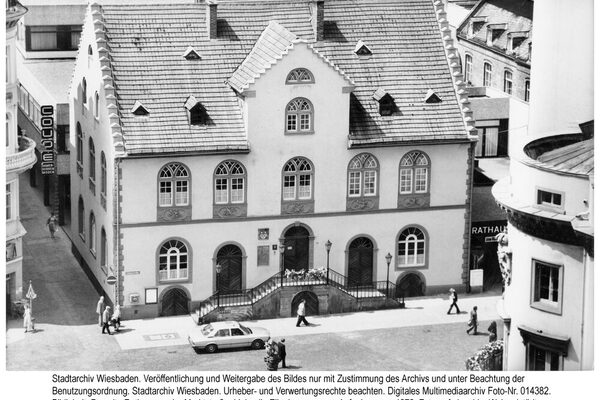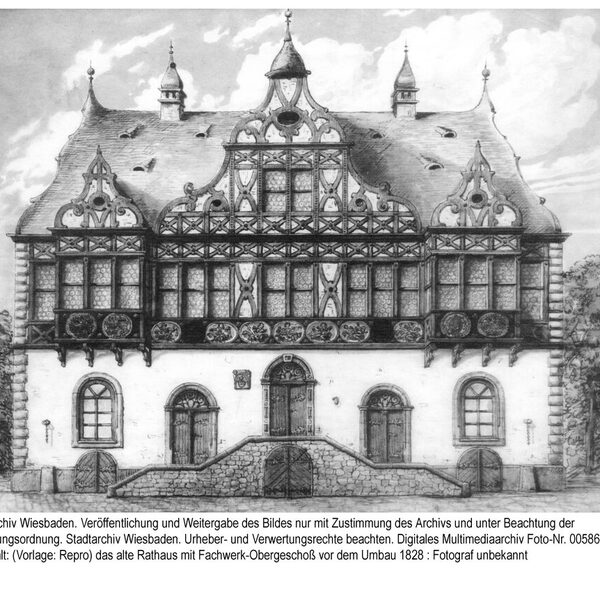Town hall, old
The old town hall is the oldest surviving building in the town. After the previous buildings had been destroyed by various town fires in the middle and end of the 16th century, the townspeople petitioned the sovereign in 1593 to provide building land for a new town hall. In 1608, Count Ludwig II of Nassau-Weilburg-Saarbrücken donated the site of the former Hattsteiner Hof to the citizens of Wiesbaden.
In 1609, construction work began under the direction of the foreman Antonius Schöffer according to the plans of the architect, master builder and later mayor Valerius Baussendorff. The upper storeys with Renaissance gables and projecting bays were built on a massive stone base storey made of serezite gneiss from the quarries near Sonnenberg and Dotzheim - with gable walls also made of stone - using elaborately designed half-timbering.
A horizontal row of colorful carved oak panels by the Strasbourg master Hans-Jacob Schütterlin with symbolic depictions adorned the compartments of the main façade. They are considered to be outstanding artistic decorative works of the profane half-timbered building of the 17th century. There are seven allegorical depictions. They depict the three Christian virtues "Fides" ("Faithfulness"), "Spes" ("Hope") and "Caritas" ("Charity") as well as the four civic virtues of antiquity "Justitia" ("Justice"), "Fortitudo" ("Fortitude"), "Temperantia" ("Temperance") and "Prudentia" ("Prudence"). The wooden reliefs also show two coat of arms panels with the coat of arms of Nassau-Idstein and the old coat of arms of Wiesbaden as well as two text cartouches to the right and left of the main entrance, which express gratitude to the sovereign and the merits of the council and citizens for the construction of the town hall. To the left above the entrance, behind the flight of steps in front, the town coat of arms with the three lilies, the year 1610 and a Renaissance border were added.
At the beginning of the 19th century, the woodwork was so badly damaged by worm damage that in 1829 the entire half-timbered upper floor was removed and the stone structure, which is still visible today, was erected without completely abandoning its character as a former Renaissance building. The plaques on the half-timbering were taken over into the Nassau Antiquities Collection and replaced with depictions carved in sandstone in 1951 when the building was renovated by the then owner, Wiesbadener Stadtwerke. The Wiesbaden sculptor Peter Dienstdorf was commissioned to do this.
The municipal administration moved in 1868. The old town hall housed the civil registry office and the weights and measures office. The local telegraph directorate of the North German Federation moved into the upper floor. Since the completion of the new town hall in 1887, the old town hall has been used for a variety of purposes. In 1875, it became the seat of Wiesbaden's first registry office. As such, the building still provides the ceremonial setting today.
Literature
Brusberg, Annette and Horst: The Old Town Hall in Wiesbaden, Wiesbaden 1985.
"In honor of the city". 400 years of the Old Town Hall of Wiesbaden 1610-2010. ed.: Czech, Hans-Jörg, Wiesbaden 2010 [pp. 5, 14-26].
Roth, Friedrich W. E.: Geschichte und historische Topographie der Stadt Wiesbaden im Mittelalter und in der Neuzeit, Wiesbaden 1883.

